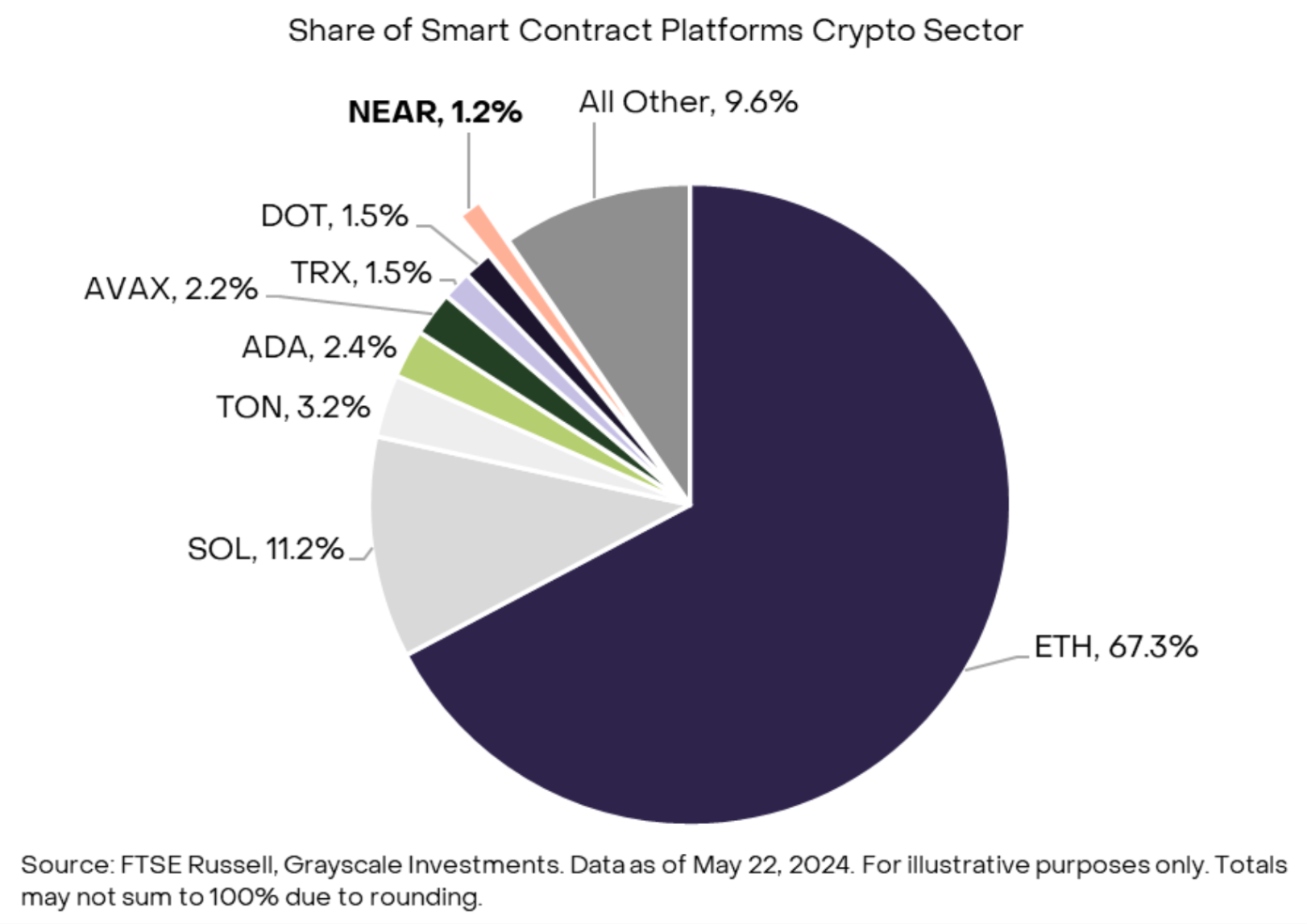Last Updated: 5/23/2024 | 7 min. read
Near is a smart contract blockchain designed to provide a scalable, low-cost platform that has made its mark onboarding users for non-financial applications and its AI capabilities.
Summary
The Near Protocol is a performant Layer 1 smart contract blockchain focused on scalability and creating a user-friendly platform. It is a component of the Smart Contract Platforms Crypto Sector (Exhibit 1). Unlike Ethereum, which relies on Layer 2 solutions for scalability, Near’s sharding[1] approach aims to deliver scalability directly at the base layer. Through its unique design choices, Near is fast, cost effective, and easy to use for developers and users alike. Unlike many other large smart contract platforms, it has already proven it can onboard new users into crypto at scale, although its fee revenue remains relatively low compared to competitors.
Exhibit 1: Near represents about 1% of the Smart Contract Platforms Crypto Sector by market capitalization

The Token
NEAR is the native token of the Near network and represents a piece of ownership in the ecosystem (Exhibit 2). The NEAR token is used for (i) securing the network through staking, (ii) paying for transaction and storage fees, (iii) acting as a medium of exchange on the network, and (iv) participating in network governance.
Exhibit 2: NEAR token basics

The Network and Technology
The Near network is designed to provide an environment that is friendly to both users and developers. Its innovative solution of sharding splits its blockchain into smaller, more manageable units called shards. This helps to reduce the data burden on individual node operators and enables parallel transaction processing across different shards. As a result, Near has highly competitive transaction throughput capacity that surpasses Ethereum and Bitcoin and rivals Solana (Exhibit 3).
Near is a pioneer in chain abstraction, where the complex underlying nuances of blockchain are simplified or hidden to enhance user experience. For example, Near allows users to create and recover accounts through an email address, lowering barriers to entry and designed to facilitate broader adoption. In addition, because Near’s cost per transaction is lower than that of competitors (Exhibit 3), the technology can potentially be applied to a wider range of applications. At the same time, its smaller fees contribute to its relative inability to monetize its user base today.
Exhibit 3: Near stands out for throughput and abstraction

Use Cases
Like most other Layer 1 smart contract blockchains, Near is a general-purpose platform for decentralized applications (dApps). It is the settlement layer for two of the most widely used dApps in all of crypto, both averaging around 1 million daily users.[2] One of the two dominant applications is KaiKai, a shopping discovery app based out of Singapore. KaiKai users that pay in Kai-Ching—a stablecoin on Near pegged to 1 US cent—are given discounted rates on in-app and store purchases.[3] The other application is Hot Protocol, a self-custodial wallet built on Near that allows for users to access Bitcoin, Ethereum, and Solana through the messaging app Telegram. In total, the Near network hosts more than 96 dApps[4] with a wide range of functions including:
- Decentralized Finance (DeFi): Order book exchanges, automated market makers, lending and borrowing platforms, and payments
- Web 3.0: Including decentralized music and open-architecture gaming
- NFTs: Minting platforms, marketplaces, and community engagement tools
Factors to Consider
Near’s sharding design allows for scalability, enabling its network to support a large number of users. Near’s use of account abstraction lowers the barrier to entry, facilitates ease of use, and connects fragmented liquidity across chains. The success with Kai-Ching and Hot Wallet offers evidence that Near can onboard non-speculative users into crypto.
In addition, Near has potential to benefit from the intersection of AI and crypto. Illia Polosukhin, Near’s founder, helped develop the “Transformer” architecture that powers AI systems like ChatGPT. Today, the protocol offers Near tasks, a peer-to-peer gig economy that allows users to enhance AI models through data labeling. Near is also hiring AI engineers as it prioritizes AI efforts in its roadmap.[5]
Finally, despite fundamental metrics like daily users and transactions that rival or surpass competitors within the Grayscale Smart Contract Platforms Crypto Sector, NEAR has a lower current market capitalization ($7 billion as of May 1, 2024).
Investment Risks
Near faces several possible risks specific to the network, which include, but are not limited to:
- Competing Networks: Near faces competition from other blockchains with smart contract functionality, such as Ethereum, as well as other high throughput chains such as Solana, Sui, Aptos, Avalanche, and others.
- Economics and Valuation: While it remains low cost for end users, Near has thus far been unable to generate substantial network revenue from fees in comparison to other blockchains such as Ethereum, Tron, Solana, and others. Near’s lower fee generation also contributes to relatively less network security.
- Level of Centralization and Network Resilience: The Near network could become overly centralized if one or a group of entities one day gain control over a large share of the Near token supply. In addition, while sharding offers scalability benefits, it comes at the relative cost of network security. As of May 2024, Near has substantially fewer validators than larger competitors such as Solana and Ethereum, which could impact centralization and network resilience.
[1] Sharding in crypto is a scaling technique that divides a blockchain network into smaller, parallel pieces (shards) to improve transaction speed and capacity.
[2] Dapp Radar as of May 6, 2024
[3] Tech Crunch
[4] Dapp Radar as of May 6, 2024
[5] Coindesk